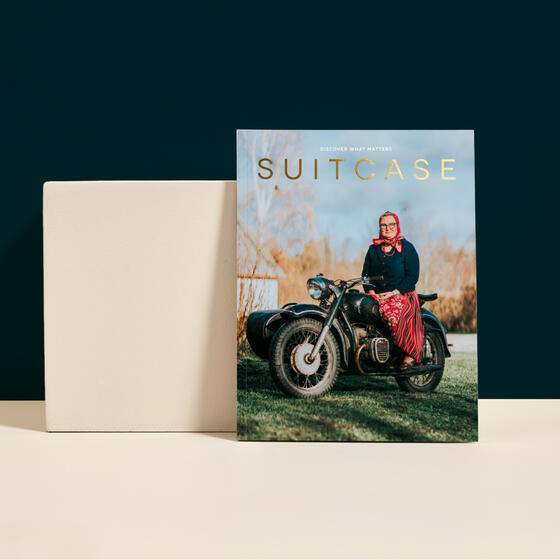Deep in Transylvania, the family behind a boutique hotel is trying to preserve its ancestral home, and revive the once-abandoned architecture of Romania’s storied mountainlands
02 December, 2022
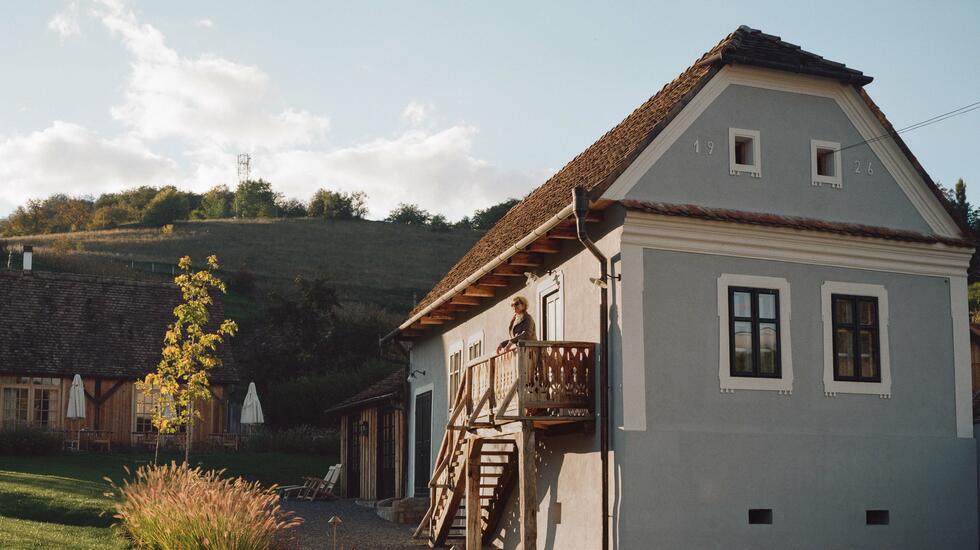
The
notion of an unexplored wilderness in Europe made me raise
my eyebrows at first. Yet as we snake between the all but empty
alpine hills and virgin forests leading to Cris – a back-in-time
Transylvanian village that will be my base for
the next two days – my suspicions dissolve before we’ve even
reached the front gate of
Bethlen Estates.
It was in this sleepy village that the late Count Miklos of
Bethlen, founder of the eponymous cultural preservation project,
spent blissful days skipping between the surrounding woodlands and
wildflower meadows as a child. Forced to flee with his family when
communism took hold across Romania after the Second World War, the count
only returned to his hometown in 1967, where he discovered a
left-for-dead community falling into ruins. Intent on breathing
life back into Cris’ cobblestone streets, he spent the next three
decades drumming up charitable funds to protect the village,
provide local scholarships and achieve Unesco status for Bethlen
Castle, his ancestral family home.
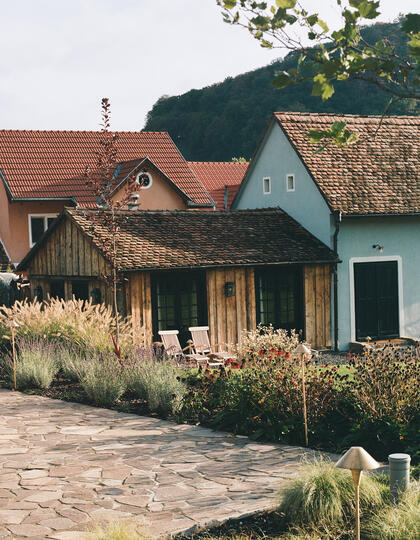
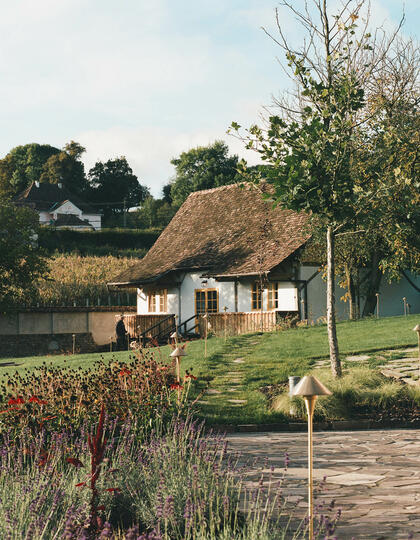
Refurbished buildings across Bethlen Estates.
Now spearheaded by his wife, Gladys, and son, Nikolaus, the late
count’s legacy project, Bethlen Estates, has evolved into an
ever-expanding circular tourism initiative that currently offers
three high-design guesthouses – each restored from tumbledown ruins
– with several more in the works. “Our aim is to channel tourism
funds straight back into the preservation of the area,” Gladys
tells me, hoisting a wicker basket onto her shoulder as we amble
around the estate. Right from the outset of the restoration
project, she and Nikolaus wanted to honour the historic craftsmanship of each building, she says – a
process that required the painstaking acquisition of traditional
local building materials and took over 15 years to complete.
The result is a design-driven clutch of properties – the
Caretaker’s House, Depner House and Corner Barn – that blends
effortlessly into the tree line and higgledy-piggledy Saxon roofs
beyond. There are 10 guest rooms in total: four in the
self-contained Caretaker’s House, two in Depner House and four in
Corner Barn, the only accommodation bookable by the room. Each of
the three properties is built around communal space, and all are
awash with rustic-chic furnishings, reclaimed 18th-century oak
beams and traditional round-tiled stoves, making my time there feel
more like a visit to a family farmhouse than a hotel. Bedrooms are
slightly more modern. In the Corner Barn, where I stayed, you’ll
find accents like contemporary-cool floor lamps and smart linen
headboards. The pretty-in-pink tiled bathrooms are piled high with
L’Occitane products.
Most impressive of all, though, is the estate’s unwavering
commitment to Cris’ community through its scholarship programme.
One beneficiary is Robert Tordai, the hotel’s head chef. Creatively
showcasing the region’s natural larder – think venison heart,
foraged mushrooms and goulash cooked over an open fire – Tordai’s
ever-tweaked set menu is geared around what he’s gathered that day,
with everything sourced from within 25km of the property. Much is
plucked straight from the estate’s grounds (such as its orchard,
the fruits of which are used to make the homemade brandy I sample
after dinner).
Soundtracked by the clink of cow bells and the odd clip-clop of
a distant horse-drawn carriage, I spend my next day meandering
through medieval villages with Peter Suciu, a tour guide with
encyclopedic local knowledge who accompanies Bethlen guests on
sightseeing excursions. Our first stop is Biertan, a Unesco World
Heritage site home to a Lutheran fortified church that presides
over the small settlement with mythical grandeur. Ringed by
concentric walls and nine imposing turrets, its triple-naved,
late-gothic architecture is complemented by beautifully preserved
Renaissance artworks and an intricate mosaicked door.
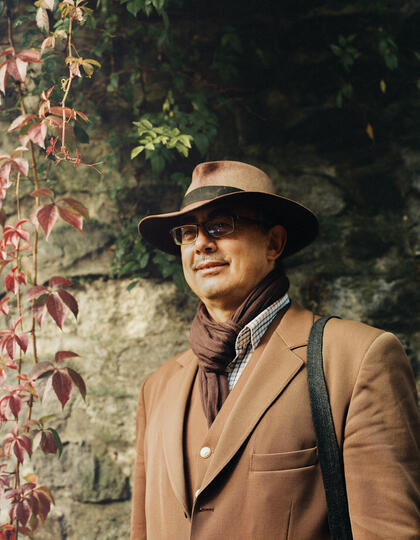
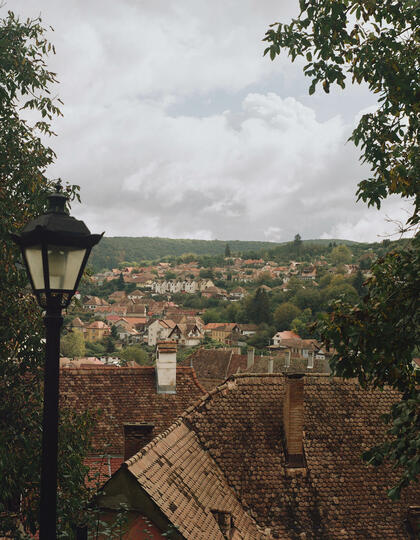
Guide Peter Suciu, left, and Sighișoara
rooftops.
Realising we’re the only ones in the church, Peter smiles and
leads me silently to the majestic altar, to the left of which is a
hidden door. “Open it,” he whispers with teenage excitement. We
slip inside, and Peter points to a formidable-looking mechanism
behind the door – a Chamber of Secrets-like bolt made up of 19
locks, all activated by a single key. Local lore tells that secret
treasure was once held here, bolted in by a feat of engineering so
show-stopping that it stole the stage at the Paris World Expo in
1900.
Back on the road, Peter and I head to the medieval citadel of
Sighișoara, another Unesco World Heritage site and the fabled
birthplace of Vlad the Impaler, the gruesome Wallachian ruler who
inspired Bram Stoker’s Dracula. As we stroll its postcard-pretty
lanes, flanked on all sides by candy-coloured merchant houses, I
half expect a gingerbread man to come winding around the corner.
One of the few towns where medieval German architecture was left
standing during the Ceaușescu years, it’s a place where time seems
to stand still, punctuated only by the hourly chime of its soaring
central clock tower.
Sighișoara might capitalise on its folkloric reputation with
kitsch souvenir shops, but beyond the Dracula figurines peering
from every window, there’s lived-in history to explore. Quiet
coffee shops exist alongside lively market squares, while cinematic
hilltop views stretch over the dense woodlands, including those
within Breite Oak Tree Reserve, the largest grassland plateau on
the continent.
One of the most well-preserved wood pastures in Eastern Europe,
the 73-hectare nature reserve is home to more than 500 trees. Some
are 800 years old. Each tree is a microcosm offering food and
shelter for hundreds of other species, from birds and frogs to
lynx, wolves and bears, as well as 476 different plants. But beyond
its ecological value, it’s Breite’s significance within the local
community that’s perhaps most valuable of all, according to
ornithologist Cosmin Moga.
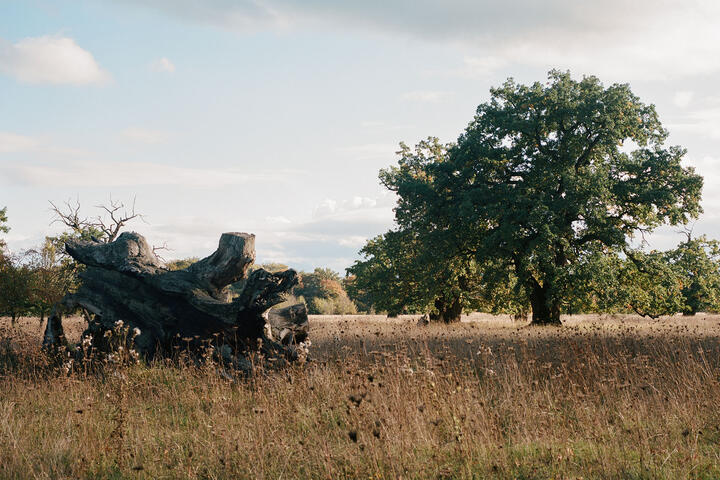
Breite Oak Tree Reserve.
“This has been a meeting place for centuries,” Cosmin explains.
“People would gather here to collect wood, and during the Great
Famine, the oaks’ acorns were used to make a hearty purée that
would feed villagers for days.” Slated to become an airport or
Dracula theme park during the communist era, the reserve was
abandoned and left to grow wild after local protests over the
planned construction grew too cumbersome to overrule. “This place
holds great ecological value, but it’s also a footprint of Saxon
anthropology and a symbol of cultural heritage,” Cosmin concludes,
running his fingers across the trunk of his favourite tree. Now a
listed member of Natura 2000 – a network of conservation areas
within the EU – the oak reserve thrives under the protection of
park rangers who roam the area day and night to prevent the
poaching of fallen wood.
Back at Bethlen Estates, I meet with the hotel’s resident
archeologist, Zólya Levente. He takes me up to Bethlen Castle. This
is the estate’s crown jewel, and the place where Count Miklos spent
his childhood. One of the largest fortified castles in Transylvania
and the Bethlen’s home for over 750 years, the castle was
commandeered by Romania’s communist government – to be used as a
film set – but by the early 90s had fallen into disrepair. In 2007,
it was given back to Bethlen Estates.
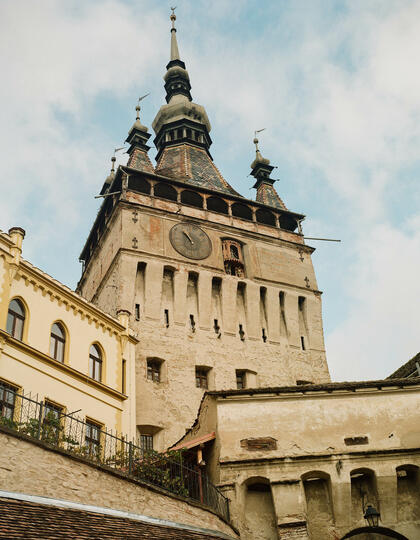
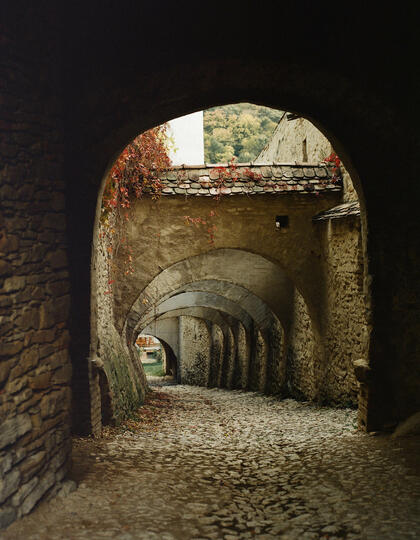
Sighișoara clock tower, left, and an old Medieval
pathway.
“We’ve been reconstructing the building ever since, but it’s a
slow process,” Zólya, who joined the team in 2020, tells me, as we
walk around the desolate ruins. “Our plan is to turn the space into
a visitors’ centre.” As we talk, he stops to point out the remains
of an intricate Renaissance fresco on the wall of a former bedroom.
It’s a glimpse of the potentially rich history buried within the
crumbling building.
Standing outside the castle, I drink in the silence that engulfs
the surrounding terraced hills. It’s a stillness that seems to
belie Transylvania’s turbulent past, and a symbol of the value in
protecting this region’s beautifully untrammelled landscape.
Mostly, though, it’s a sharp reminder to myself that there is, in
fact, a genuine wildness still to be found in Europe, if you only
look hard enough.
Read about the modern witches of Romania in
Vol. 39: Ritual
